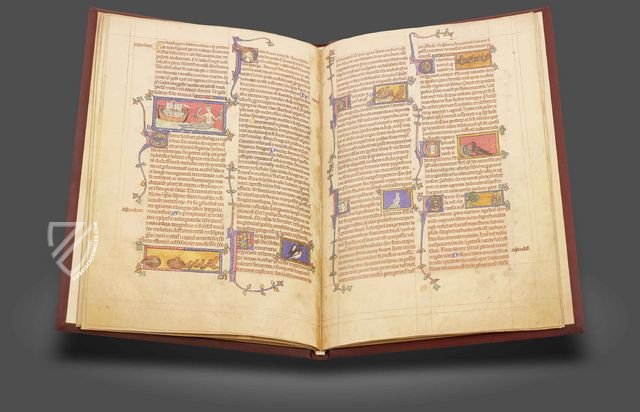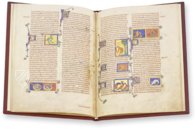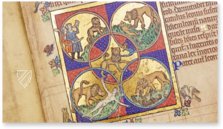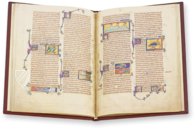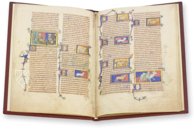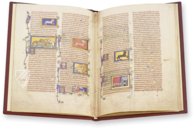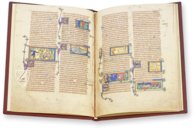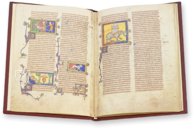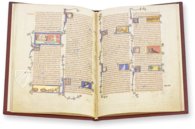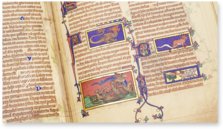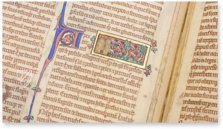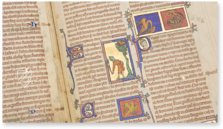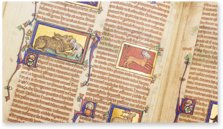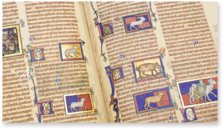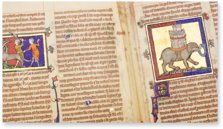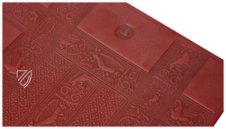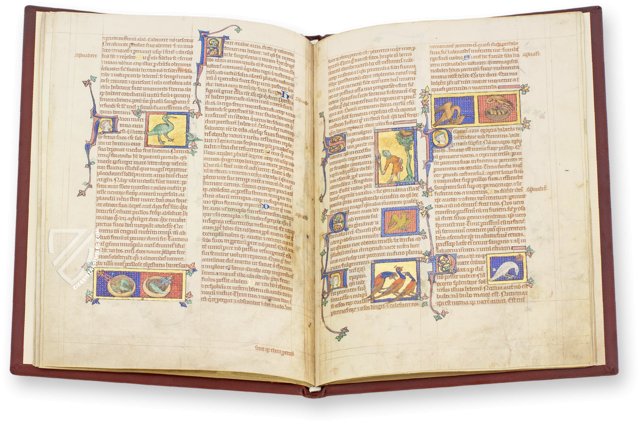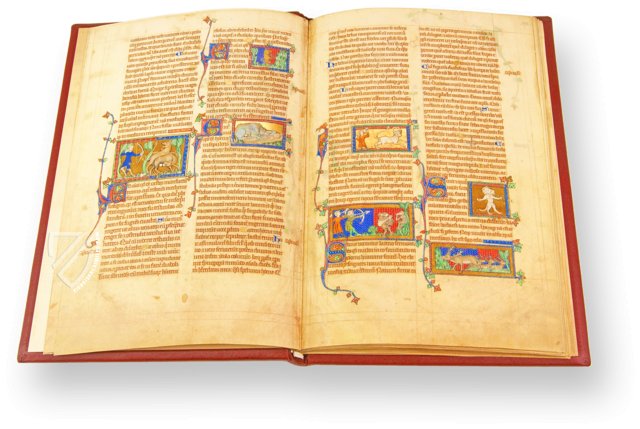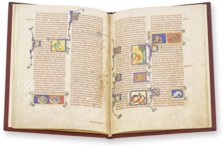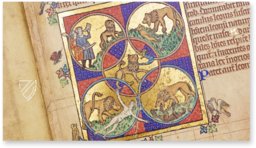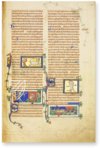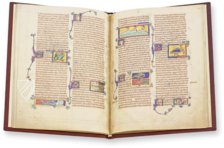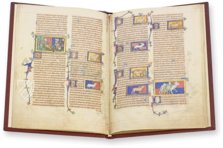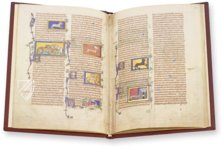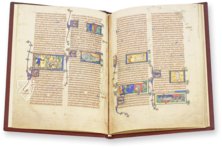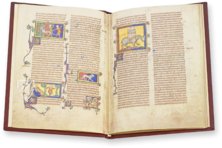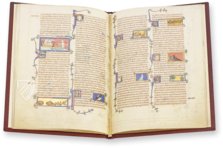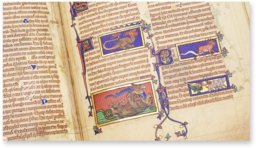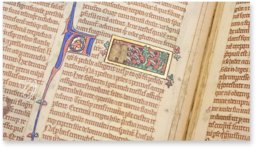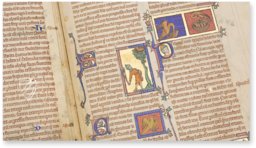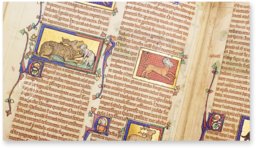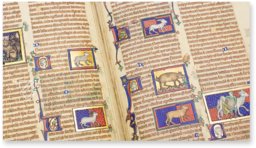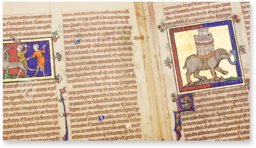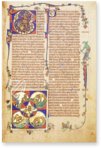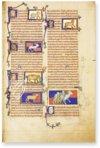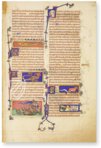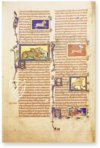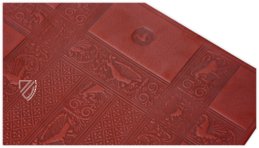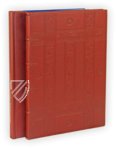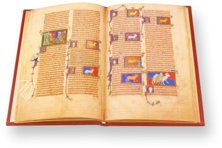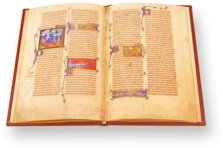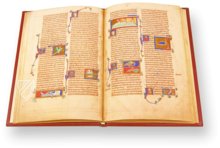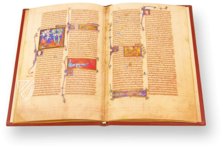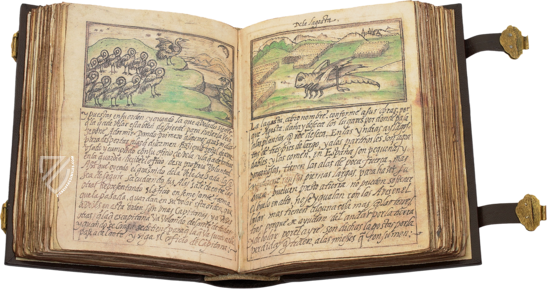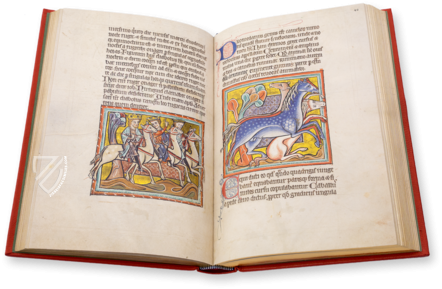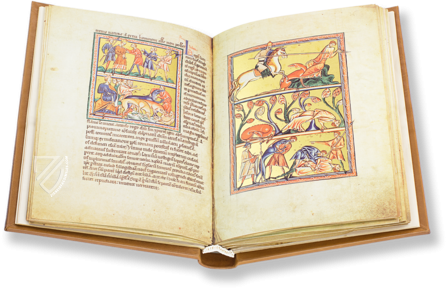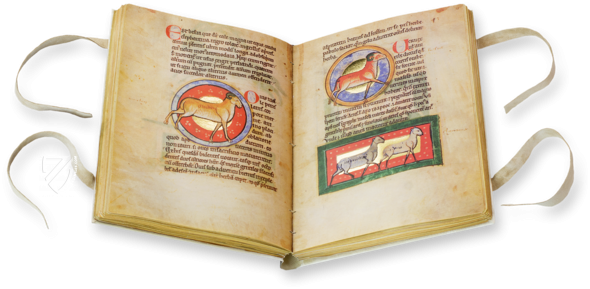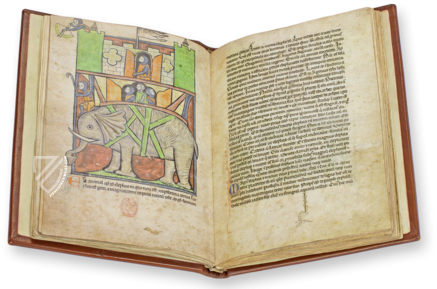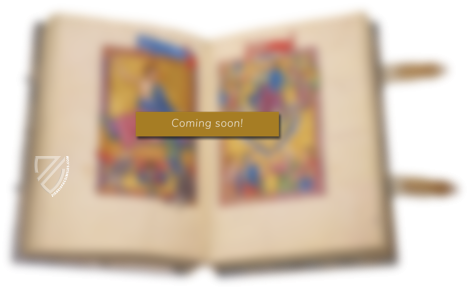Peterborough Bestiary
(1,000€ - 3,000€)
In the 12th and 13th centuries, bestiaries were real bestsellers. The animal poems were particularly widespread in England and France and appeared in many wonderfully illuminated manuscripts, whose texts not only tell of native animals but also of all kinds of non-European and even mythical animals and hybrid creatures. The described characteristics and behaviour of the beasts are interpreted in a Christian moralizing sense and often combined with advice for the reader. One of the most beautiful later examples of such animal poetry is the Peterborough Bestiary. In over 100 wondrous miniatures, animals such as unicorns, phoenixes, elephants and dragons are depicted against multicolored or golden backgrounds. Almost every paragraph has been artfully illuminated by the talented Master of the Jesus College. Each passage is also introduced by a gold-decorated initial, usually adorned with exuberant tendrils, lending the work not only visual clarity but also opulence. A true pinnacle of the bestiary tradition!
Peterborough Bestiary
The Peterborough Bestiary represents quite an influential example of the much beloved era of 12th century animal-themed manuscripts. Countless small picture fields illustrate the descriptive and interpretive text, which is illustrated with wonderful initials and tendrils. Within this text one finds familiar as well as exotic animals and mythical creatures, which are displayed as lovingly and realistically as possible.
Fantastic Depictions of Animals
In over 100 miniatures on gold grounds or in gold frames, one finds animals such as lions, beavers, different sorts of birds, crocodiles, and elephants, but also mythical creatures like unicorns, phoenixes, and satyrs. They illustrate the relevant text passages and include exhaustive detail in describing each animal individually, most of which have a Christian or moral connection. For example, there is an illustration of a crow with the purpose of representing the love and worry one experiences when raising children. The text is based on the Physiologus, composed ca. A.D. 200, which was an early Christian text that concerned itself with nature. Over the following centuries, Physiologus was amended and added to many times (for example, through Isidore of Seville’s Etymologiae), and translated into many other languages, which inevitably changed it as well. Moving to the High Middle Ages, such descriptions of nature and myth became beloved subjects and offered illuminators the opportunity to be inspired to create their own depictions of animals in nature.
Glorious Design
It was not always an easy task for the artists to paint pictures of exotic animals, because they had never seen such creatures before. The only available templates were based off the descriptions of others that themselves drifted into the fantastic. The artist of the Peterborough Bestiary designed his manuscript in a diverse way. The depictions of animals are directly integrated with the text itself and not isolated in boxes separate from the words. The small rectangular pictures of fields are brightly colored and richly furnished with gold. The artistic style appears very Gothic in the natural depictions of the animals, who are often shown in a burst of movement. In addition to the animal representations, the other artistic designs of the bestiary are inspiring. Many initials adorn the text alongside the artful foliage. The initials are partially filled with wonderful portraits of men and women, some of them ornamentally designed.
Exotic Magic
In these magnificent pictures, the reader could plunge him or herself into the study of these informative but also amusing readings and can get to know the exotic realms, which they had surely never seen before. This instance of the exotic and unknown is owed to the presence of such mystical creatures as the unicorn or satyr, who are juxtaposed with more typical animals in everyday life. The fact that such bestiaries were made particularly in England and Northern France for both clerical and lay patrons, testifies to both their educational and entertainment value, which, despite the advances of scientific knowledge, still shines through for the modern reader and beholder.
Codicology
- Alternative Titles
- Bestiarium aus Peterborough
Bestiario di Peterborough - Size / Format
- 44 pages / 34.8 × 23.6 cm
- Origin
- United Kingdom
- Date
- Ca. 1300–1310
- Epochs
- Style
- Genre
- Script
- Gothic Textura
- Illustrations
- 104 miniatures, 108 initials, various drolleries and marginalia adorn all pages of the manuscript
- Content
- Bestiary
- Artist / School
- Master of the Jesus College MS D.40
- Previous Owners
- Peterborough Abbey
Matthew Parker (1504–75)
Peterborough Bestiary
Dragons
Whether people in the Middle Ages actually believed that there were exotic regions of the world that were inhabited by dragons or if the fearsome mythical creatures were intentionally utilized for their symbolism by artists and scholars, they are present in virtually all medieval bestiaries. The upper miniature shows a dragon with a second head on the end of its tail. Meanwhile, another dragon battles in the sea with some kind of horned monster who has the dragon’s head in its mouth.
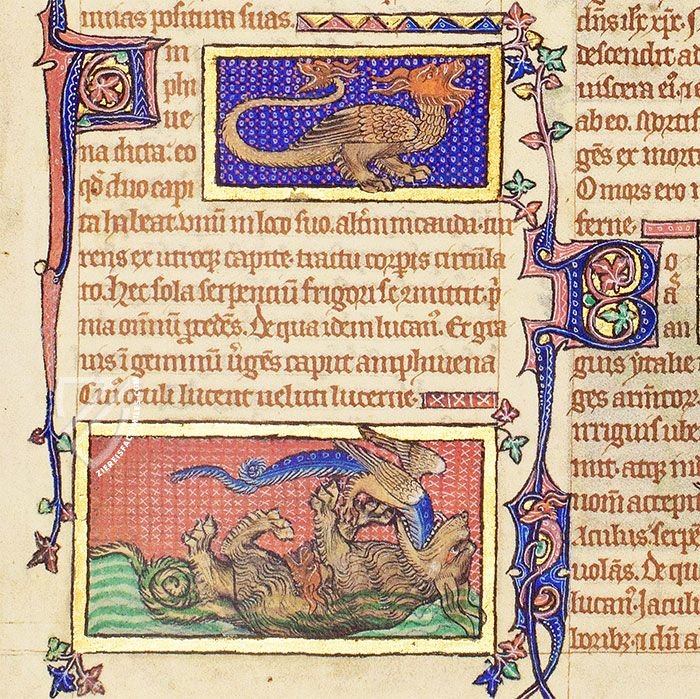
Peterborough Bestiary
The Lion
In medieval allegory, the lion was a symbol of power, strength, courage, and generosity with symbolic significance to both the Judeo-Christian tradition as well as in ancient mysticism. The page at hand features both a miniature and a historiated initial with a seated lion looking out at the beholder. All is depicted in rich shades of red and blue with shimmering gold leaf.
In the lower left corner, a miniature shows five scenes from the life of a lion: it is being hunted in one and attacked by a snake in another, but in the other three we see animal, ape, and man alike fall prey to the mighty king of beasts. Birds fill the artfully rendered tendril borders, including a hybrid creature with an archer emerging from the body of a falcon.
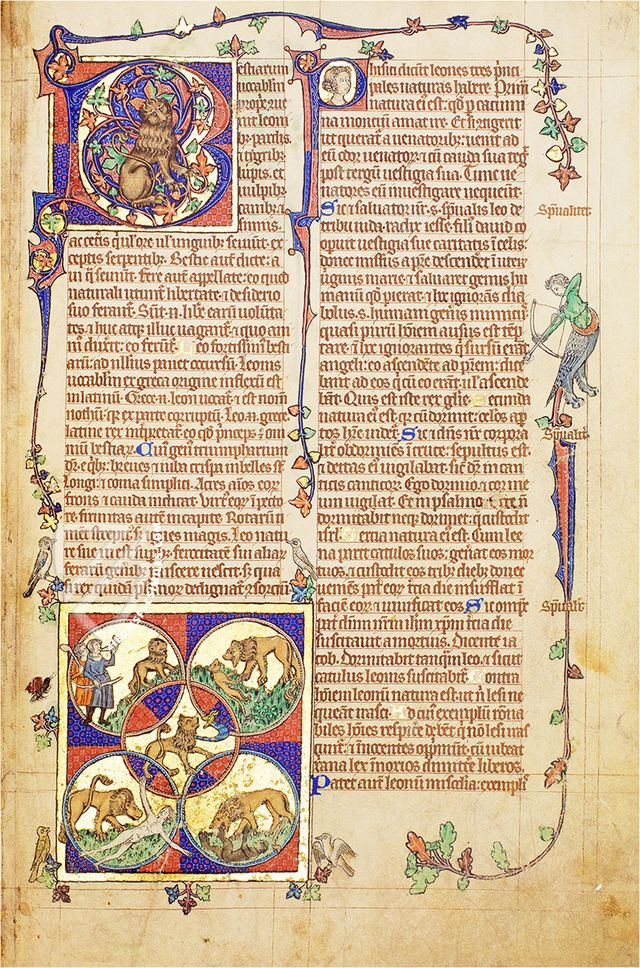
#1 Bestiarium aus Peterborough
Languages: English, German
The scholarly commentary volume provides a complete transcription and translation of the texts.
(1,000€ - 3,000€)
#2 Bestiario di Peterborough
Language: Italian
(1,000€ - 3,000€)
- Treatises / Secular Books
- Apocalypses / Beatus
- Astronomy / Astrology
- Bestiaries
- Bibles / Gospels
- Chronicles / History / Law
- Geography / Maps
- Saints' Lives
- Islam / Oriental
- Judaism / Hebrew
- Single Leaf Collections
- Leonardo da Vinci
- Literature / Poetry
- Liturgical Manuscripts
- Medicine / Botany / Alchemy
- Music
- Mythology / Prophecies
- Psalters
- Other Religious Books
- Games / Hunting
- Private Devotion Books
- Other Genres
- Afghanistan
- Armenia
- Austria
- Belgium
- Belize
- Bosnia and Herzegovina
- China
- Colombia
- Costa Rica
- Croatia
- Cyprus
- Czech Republic
- Denmark
- Egypt
- El Salvador
- Ethiopia
- France
- Germany
- Greece
- Guatemala
- Honduras
- Hungary
- India
- Iran
- Iraq
- Israel
- Italy
- Japan
- Jordan
- Kazakhstan
- Kyrgyzstan
- Lebanon
- Liechtenstein
- Luxembourg
- Mexico
- Morocco
- Netherlands
- Palestine
- Panama
- Peru
- Poland
- Portugal
- Romania
- Russia
- Serbia
- Spain
- Sri Lanka
- Sweden
- Switzerland
- Syria
- Tajikistan
- Turkey
- Turkmenistan
- Ukraine
- United Kingdom
- United States
- Uzbekistan
- Vatican City
- A. Oosthoek, van Holkema & Warendorf
- Aboca Museum
- Ajuntament de Valencia
- Akademie Verlag
- Akademische Druck- u. Verlagsanstalt (ADEVA)
- Aldo Ausilio Editore - Bottega d’Erasmo
- Alecto Historical Editions
- Alkuin Verlag
- Almqvist & Wiksell
- Amilcare Pizzi
- Andreas & Andreas Verlagsbuchhandlung
- Archa 90
- Archiv Verlag
- Archivi Edizioni
- Arnold Verlag
- ARS
- Ars Magna
- ArtCodex
- AyN Ediciones
- Azimuth Editions
- Badenia Verlag
- Bärenreiter-Verlag
- Belser Verlag
- Belser Verlag / WK Wertkontor
- Benziger Verlag
- Bernardinum Wydawnictwo
- BiblioGemma
- Biblioteca Apostolica Vaticana (Vaticanstadt, Vaticanstadt)
- Bibliotheca Palatina Faksimile Verlag
- Bibliotheca Rara
- Boydell & Brewer
- Bramante Edizioni
- Bredius Genootschap
- Brepols Publishers
- British Library
- C. Weckesser
- Caixa Catalunya
- Canesi
- CAPSA, Ars Scriptoria
- Caratzas Brothers, Publishers
- Carus Verlag
- Casamassima Libri
- Centrum Cartographie Verlag GmbH
- Chavane Verlag
- Christian Brandstätter Verlag
- Circulo Cientifico
- Club Bibliófilo Versol
- Club du Livre
- CM Editores
- Collegium Graphicum
- Collezione Apocrifa Da Vinci
- Comissão Nacional para as Comemorações dos Descobrimentos Portugueses
- Coron Verlag
- Corvina
- CTHS
- D. S. Brewer
- Damon
- De Agostini/UTET
- De Nederlandsche Boekhandel
- De Schutter
- Deuschle & Stemmle
- Deutscher Verlag für Kunstwissenschaft
- DIAMM
- Droz
- E. Schreiber Graphische Kunstanstalten
- Ediciones Boreal
- Ediciones Grial
- Ediclube
- Edições Inapa
- Edilan
- Editalia
- Edition Deuschle
- Edition Georg Popp
- Edition Leipzig
- Edition Libri Illustri
- Editiones Reales Sitios S. L.
- Éditions de l'Oiseau Lyre
- Editions Medicina Rara
- Editorial Casariego
- Editorial Mintzoa
- Editrice Antenore
- Editrice Velar
- Edizioni Edison
- Egeria, S.L.
- Eikon Editores
- Electa
- Emery Walker Limited
- Enciclopèdia Catalana
- Eos-Verlag
- Ephesus Publishing
- Ernst Battenberg
- Eugrammia Press
- Extraordinary Editions
- Fackelverlag
- Facsimila Art & Edition
- Facsimile Editions Ltd.
- Facsimilia Art & Edition Ebert KG
- Faksimile Verlag
- Feuermann Verlag
- Folger Shakespeare Library
- Franco Cosimo Panini Editore
- Friedrich Wittig Verlag
- Fundación Hullera Vasco-Leonesa
- G. Braziller
- Gabriele Mazzotta Editore
- Gebr. Mann Verlag
- Gesellschaft für graphische Industrie
- Getty Research Institute
- Giovanni Domenico de Rossi
- Giunti Editore
- Graffiti
- Grafica European Center of Fine Arts
- Guido Pressler
- Guillermo Blazquez
- Gustav Kiepenheuer
- H. N. Abrams
- Harrassowitz
- Harvard University Press
- Helikon
- Hendrickson Publishers
- Henning Oppermann
- Herder Verlag
- Hes & De Graaf Publishers
- Hoepli
- Holbein-Verlag
- Houghton Library
- Hugo Schmidt Verlag
- Idion Verlag
- Il Bulino, edizioni d'arte
- ILte
- Imago
- Insel Verlag
- Insel-Verlag Anton Kippenberger
- Instituto de Estudios Altoaragoneses
- Instituto Nacional de Antropología e Historia
- Istituto dell'Enciclopedia Italiana - Treccani
- Istituto Ellenico di Studi Bizantini e Postbizantini
- Istituto Geografico De Agostini
- Istituto Poligrafico e Zecca dello Stato
- Italarte Art Establishments
- Jan Thorbecke Verlag
- Johnson Reprint Corporation
- Josef Stocker
- Josef Stocker-Schmid
- Jugoslavija
- Karl W. Hiersemann
- Kasper Straube
- Kaydeda Ediciones
- Kindler Verlag / Coron Verlag
- Kodansha International Ltd.
- Konrad Kölbl Verlag
- Kurt Wolff Verlag
- La Liberia dello Stato
- La Linea Editrice
- La Meta Editore
- Lambert Schneider
- Landeskreditbank Baden-Württemberg
- Leo S. Olschki
- Les Incunables
- Liber Artis
- Library of Congress
- Libreria Musicale Italiana
- Lichtdruck
- Lito Immagine Editore
- Lumen Artis
- Lund Humphries
- M. Moleiro Editor
- Maison des Sciences de l'homme et de la société de Poitiers
- Manuscriptum
- Martinus Nijhoff
- Maruzen-Yushodo Co. Ltd.
- MASA
- Massada Publishers
- McGraw-Hill
- Metropolitan Museum of Art
- Militos
- Millennium Liber
- Müller & Schindler
- Nahar - Stavit
- Nahar and Steimatzky
- National Library of Wales
- Neri Pozza
- Nova Charta
- Oceanum Verlag
- Odeon
- Orbis Mediaevalis
- Orbis Pictus
- Österreichische Staatsdruckerei
- Oxford University Press
- Pageant Books
- Parzellers Buchverlag
- Patrimonio Ediciones
- Pattloch Verlag
- PIAF
- Pieper Verlag
- Plon-Nourrit et cie
- Poligrafiche Bolis
- Presses Universitaires de Strasbourg
- Prestel Verlag
- Princeton University Press
- Prisma Verlag
- Priuli & Verlucca, editori
- Pro Sport Verlag
- Propyläen Verlag
- Pytheas Books
- Quaternio Verlag Luzern
- Reales Sitios
- Recht-Verlag
- Reichert Verlag
- Reichsdruckerei
- Reprint Verlag
- Riehn & Reusch
- Roberto Vattori Editore
- Rosenkilde and Bagger
- Roxburghe Club
- Salerno Editrice
- Saltellus Press
- Sandoz
- Sarajevo Svjetlost
- Schöck ArtPrint Kft.
- Schulsinger Brothers
- Scolar Press
- Scrinium
- Scripta Maneant
- Scriptorium
- Shazar
- Siloé, arte y bibliofilia
- SISMEL - Edizioni del Galluzzo
- Sociedad Mexicana de Antropología
- Société des Bibliophiles & Iconophiles de Belgique
- Soncin Publishing
- Sorli Ediciones
- Stainer and Bell
- Studer
- Styria Verlag
- Sumptibus Pragopress
- Szegedi Tudomànyegyetem
- Taberna Libraria
- Tarshish Books
- Taschen
- Tempus Libri
- Testimonio Compañía Editorial
- Thames and Hudson
- The Clear Vue Publishing Partnership Limited
- The Facsimile Codex
- The Folio Society
- The Marquess of Normanby
- The Richard III and Yorkist History Trust
- Tip.Le.Co
- TouchArt
- TREC Publishing House
- TRI Publishing Co.
- Trident Editore
- Tuliba Collection
- Typis Regiae Officinae Polygraphicae
- Union Verlag Berlin
- Universidad de Granada
- University of California Press
- University of Chicago Press
- Urs Graf
- Vallecchi
- Van Wijnen
- VCH, Acta Humaniora
- VDI Verlag
- VEB Deutscher Verlag für Musik
- Verlag Anton Pustet / Andreas Verlag
- Verlag Bibliophile Drucke Josef Stocker
- Verlag der Münchner Drucke
- Verlag für Regionalgeschichte
- Verlag Styria
- Vicent Garcia Editores
- W. Turnowski Ltd.
- W. Turnowsky
- Waanders Printers
- Wiener Mechitharisten-Congregation (Wien, Österreich)
- Wissenschaftliche Buchgesellschaft
- Wissenschaftliche Verlagsgesellschaft
- Wydawnictwo Dolnoslaskie
- Xuntanza Editorial
- Zakład Narodowy
- Zollikofer AG

